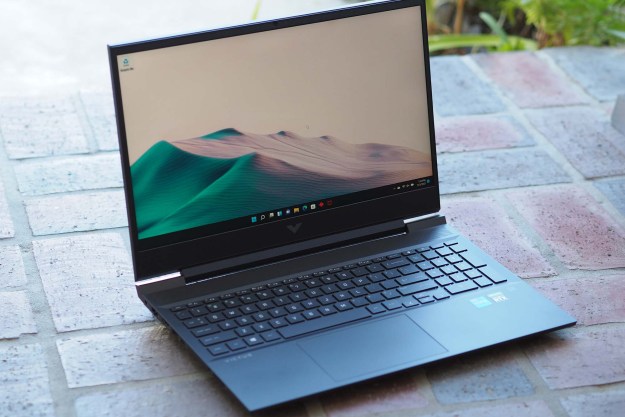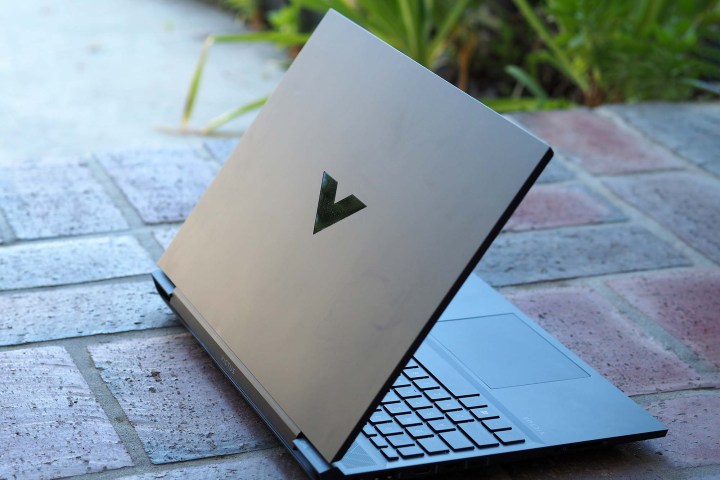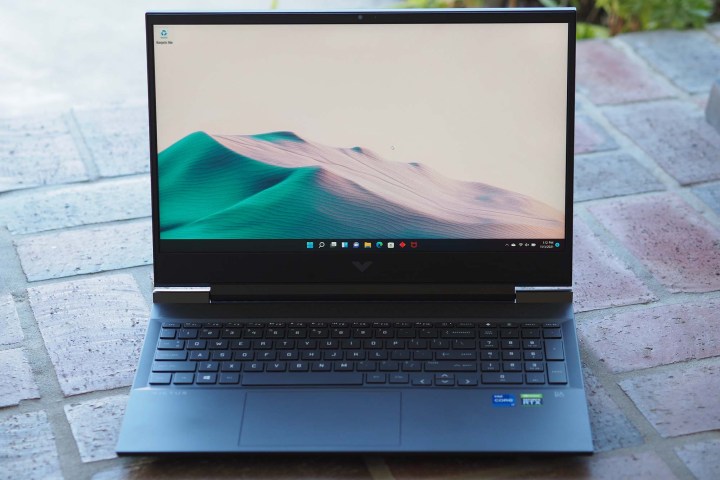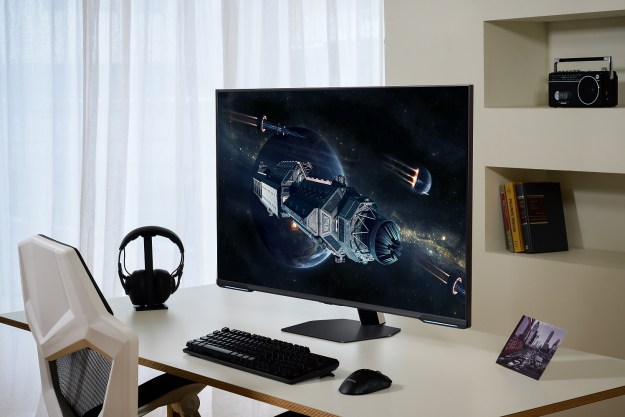
“The HP Victus 16 is a solid gaming laptop at an affordable price.”
- Excellent productivity performance
- Solid 1080p gaming performance
- Comfortable keyboard
- Display is good for both productivity and gaming
- Reasonably priced
- Build quality is subpar
- Keyboard backlighting is limited
- Poor battery life
Gaming laptops have never been more popular, and HP has a new line of devices to meet the surge in interest. Victus is the name, and it sits under HP’s premium Omen gaming brand and replaces the budget-level Pavilion gaming machines.
HP Victus brings a more premium design, souped-up internals, and Windows 11. I was sent a high-end configuration with a Core i7-11800H and Nvidia GeForce RTX 3060 that’s priced at $1,360.
That’s a fair price for a moderately equipped gaming laptop — the closest Omen 16 configuration I could put together costs $1,950 by comparison. Given the price difference and great performance, the HP Victus 16 has already made its mark in the world of affordable gaming laptops.
Design

The first thing you might notice if you’re familiar with the Omen line is the Victus logo. It’s a “V” based on the same core geometry as the Omen logo, with the bottom portion essentially isolated to stand on its own. The logo’s not only on the outside lid and on the display chin, but it’s also embedded in the venting above the keyboard and outlines the venting on the chassis bottom. If nothing else, the Victus has its branding down.
The rest of the Victus 16’s aesthetic is minimalist, with few nods to a more flashy gaming design. In fact, the only real gaming design element is the row of vents along the back of the chassis. They lend some visual flair while also providing enhanced thermals (more on that in a bit). My review unit was in the Mica Silver (black) color; Performance Blue and Ceramic White are the other options.
Overall, the Victus 16 is a gaming laptop inside a more traditional laptop design. We’ve seen that with a few other gaming machines, such as the conservatively designed (and much more expensive) Razer Blade 15 and the Asus ROG Zephyrus G14, which, other than its lid and rear venting, also sports a nongaming aesthetic. The Lenovo Legion 5 Pro lives in both worlds at once, with a businesslike design with some gaming elements like aggressive vents seemingly pasted on. Conversely, the Asus ROG Strix G15 and the Alienware
The Victus 16 has reasonably small bezels for a gaming machine, at least on top and along the sides. Even with a massive chin, the combination results in an 84% screen-to-body ratio — not bad for a gaming laptop. That made it possible to fit the 16-inch display into a chassis that’s closer to a 15-inch gaming machine. The Legion 5 Pro has smaller bezels around its 16-inch, 16:10 aspect ratio display and is almost identical to the Victus 16, which sports an old-school 16:9 panel, in width and depth.
The Asus ROG Strix G15, with a 15.6-inch, 16:9 display, is fractions of an inch wider and deeper. The Victus 16 is 0.93 inches thick and weighs 5.5 pounds, compared to the Legion 5 Pro at 1.1 inches and 5.4 pounds and the ROG Strix G15 at about an inch and 5.7 pounds. That makes the Victus 16 a reasonably sized gaming laptop given the display and components. You can get thinner gaming

One area where the Victus 16 doesn’t quite live up to its price is its build quality. It’s an all-plastic laptop, which is fine, but the lid is too bendable and the keyboard deck has enough flex that you can feel your fingers pressing against whatever’s directly underneath the keyboard and palm rest. The Legion 5 Pro and ROG Strix G15 felt sturdier to us, and those are about the same price as the Victus 16. The hinge was incredibly wobbly, easy to open with one hand but prone to shaking during gaming sessions. Maybe the build quality carried over from the budget-oriented Pavilion Gaming line, but HP might want to improve it in future generations.
One of the more meaningful upgrades from the Pavilion Gaming 16 is the thermal design. HP incorporated a new system with five-way airflow thanks to an additional outlet vent on the RTX 3060 model, four heat pipes, and larger fans. The result is a 30% increase in airflow, according to HP, which makes the laptop rather loud when working hard but keeps it cooler than its predecessor. As we’ll see in the performance section below, the Victus 16 makes the most of its components, and that’s in part due to the excellent thermal design.
There’s a mix of connections available on the Victus 16, with a focus on being able to connect numerous gaming peripherals. There’s an Ethernet port, a full-size HDMI port, a USB-A 3.2 port, a USB-C 3.2 port, a 3.5mm audio jack, and a full-size SD card reader along the left-hand side, and two more USB-A 3.2 ports along the right-hand side. Juice is provided by a massive 200-watt power brick and a proprietary barrel connector.
There’s no Thunderbolt 4 support, though, which is disappointing. Wi-Fi 6 and Bluetooth 5.1 provide wireless connectivity.
Performance
The Victus 16 is equipped with a 45-watt, eight-core/16-thread Intel Core i7-11800H — a workhorse among Intel’s lineup that provides some of the best creative application performance you’ll find outside of AMD’s Ryzen 5000 series. That’s not to mention its productivity performance, which is overkill for even demanding office workers.
There’s nothing that says a gaming laptop can’t be used to get work done, and so it’s worth looking at how well the Victus 16 performs on non-gaming tasks. Consider my wife, an interior designer: She was handed an Alienware gaming laptop as her work machine because it sports both a fast CPU and a discrete GPU for speeding up applications like AutoCAD, Revit, CET, and the Adobe suite. The HP Victus 16 would fit in an office setting more discretely than an Alienware machine, that’s for sure.

In any event, the Victus 16 is undoubtedly a fast laptop even compared to comparably equipped mainstream
In PugetBench, which uses Premiere Pro to crunch through a series of demanding tasks and that can utilize a discrete GPU, the Victus 16 again achieved the highest score among its closest competitors.
If you’re looking for a fast laptop for productivity and creative tasks, then you can’t go wrong with the HP Victus 16. It pushes its components to the extreme, thanks mainly to its excellent thermal design, and it’s certainly faster than your typical mainstream — and often thin and light — laptop. Note that you can also purchase the Victus 16 with an AMD Ryzen 7 4800H if you’d like even faster CPU performance.
| Laptop | Geekbench 5 | Cinebench R23 | PugetBench (Premiere Pro) |
Handbrake (seconds) |
PCMark 10 |
| HP Victus 16 (Core i7-11800H) | 1594 / 9141 | 1510 / 10145 | 765 | 91 | 6808 |
| Lenovo ThinkPad X1 Extreme Gen 4 (Core i7-11800H) | 1520 / 7353 | 1519 / 10497 | 388 | 99 | 6251 |
| Dell XPS 15 OLED 2021 (Core i7-11800H) | 1544 / 7692 | 1513 / 9979 | 509 | 101 | 6024 |
| MSI Creator Z16 (Core i7-11800H) | 1540 / 7625 | 1444 / 9615 | 738 | 103 | 6486 |
| Dell XPS 17 (Core i7-11800H) | 1568 / 8801 | 1525 / 10145 | 692 | n/a | 6209 |
| LG Gram 16 (Core i7-1165G7) | 1573 / 5454 | 1394 / 4137 | N/A | 213 | 4827 |
| Lenovo Legion 5 Pro (Ryzen 7 5800H) | 1460 / 7227 | 1430 / 11195 | 622 | 99 | n/a |
Gaming

But of course, the Victus 16 is a gaming laptop, and so it should be measured against other gaming
I ran all the benchmarks — including those in the section above — in both default and performance modes and saw very little difference in performance. In most games, performance mode squeezed out only a few extra frame rates.
Its 3DMark Time Spy score was in line with our comparison group, coming in next-to-last place, with only the MSI Creator Z16 — a nongaming machine with the same GPU that I added for comparison purposes — posting a lower score.
In actual games, the Victus 16 did well. It managed to come within a couple of frames of the Razer Blade 14 and Lenovo Legion 5 Pro in Assassin’s Creed Valhalla — and both of those are equipped with RTX 3070s. It almost matched the Lenovo Legion 5 Pro in Battlefield V, and it beat out the Razer Blade 14 in Fortnite. Finally, it beat both the RTX 3070-equipped machines in Civilization VI.
Best yet, these are very playable frame rates across the board, making the Victus 16 a highly capable 1080p gaming machine. These results are all at high graphical settings, meaning you don’t need to turn things down to maintain high frame rates. For a gaming laptop equipped with an RTX 3060, the Victus 16 is competitive. If you select the AMD version of the laptop, you can opt for a slower AMD Radeon RX5500M GPU to save some cash.
| Laptop | 3DMark Time Spy | Assassin’s Creed Valhalla (1080p Ultra High) |
Battlefield V (1080p Ultra) |
Fortnite (1080p Epic) |
Civilization VI (1080p Ultra) |
| HP Victus 16 (RTX 3060) | 7341 | 59 fps | 72 fps | 99 fps | 118 fps |
| Razer Blade 14 (RTX 3070) | 8605 | 60 fps | 96 fps | 96 fps | 111 fps |
| Lenovo Legion 5 Pro (RTX 3070) | 9175 | 61 fps | 73 fps | 101 fps | 114 fps |
| Asus ROG Strix G15 (RX 6800M) | 10504 | 77 fps | 109 fps | 108 fps | 150 fps |
| MSI GS66 Stealth (RTX 3080) | 9097 | 70 fps | 117 fps | 140 fps | 149 fps |
| Razer Blade 15 (RTX 2080 Super) | 7637 | 58 fps | 98 fps | 110 fps | 134 fps |
| MSI Creator Z16 (RTX 3060) | 6322 | 50 fps | 57 fps | 56 fps (1600p) | 92 fps |
The Victus 16 moves a lot of air when it’s working hard, and so fan noise was quite audble. It’s not enough to force you to wear headphones at all times, but you might choose to do so nonetheless. The surface of the laptop remained reasonable, hitting 101 degrees Fahrenheit on the right side of the keyboard deck during benchmarking. The bottom of the chassis didn’t exceed 115 degrees F during my testing. During nongaming use, the laptop remained cool and quiet.
According to 3DMark, GPU temperatures ran between about 75 degrees C and 100 degrees C at the maximum, which is the highest possible safe temperature. We don’t typically like to see temperatures get that high, and you’ll find better thermals in
Configurations
While our $1,360 review configuration was at the high end — with the Core i7-11800H, RTX 3060, 16GB of
The most you can spend is $1,640 by upgrading our configuration to 32GB of
If you want to save money but not compromise so much on performance, then you can still keep your purchase price under $1,000. For $920, you can get the Core i5, an RTX 3050 Ti, 8GB of
Display

Gaming
But as I used the display, it seemed like a similar panel to what I might find on a premium thin and light laptop aimed at productivity work. It was bright, with dynamic colors that weren’t oversaturated and enough contrast that blacks stood out from whites.
I was very pleased with the Victus 16’s display.
My colorimeter confirmed my impressions. The display is indeed bright at 375 nits, well above our 300-nit threshold, and the contrast came in at 1120:1, exceeding our preferred 1000:1. Colors were wider than average at 79% of AdobeRGB (where around 72% is the norm) and 100% of sRGB, and they were fairly accurate at a DeltaE of 1.85 (1.0 or less is considered excellent).
The Asus ROG Strix G15 wasn’t nearly as good, coming in at 278 nits, a 1,090:1 contrast ratio (a good result), and just 48% of AdobeRGB and 64% of sRGB with a color accuracy of 2.19. The Legion 5 Pro’s display was also good at 515 nits, a 1,380:1 contrast ratio, 74% of AdobeRGB and 97% of sRGB, and a color accuracy of 1.36.
I was very pleased with the Victus 16’s display. Not only is it fast for gaming, but it can perform well for productivity work. It can even do some creative work in a pinch thanks to its fast performance.
The audio wasn’t quite as impressive. The two downward-firing speakers were very quiet even when turned up all the way, although there was no distortion. Mids and highs were clear enough, but the bass was lacking. You’ll want a pair of headphones when you’re gaming at full strength because the sound won’t be loud enough to overcome the fan noise comfortably. The same goes for bingeing Netflix and listening to music — headphones are a must.
Keyboard and touchpad

Here’s one thing the Victus 16 did not inherit from the Omen line: Per-key RGB lighting on the keyboard. In fact, although the Victus 16’s keyboard is indeed backlit with white lighting, it’s only on or off with no levels in between. So, HP has very carefully ensured that the Omen retains its advantage here. The keyboard feels great, though, with deep travel and very snappy switches that provide excellent responsiveness for both gamers and productivity users. It’s not a mechanical keyboard, but it shouldn’t hold back competitive gamers.
The touchpad is increased in size over the Pavilion Gaming 16, and it takes up most of the available space on the palm rest. It has a comfortable surface for swiping, but I found the buttons a little loose, and they vibrated just a touch when pressed. It’s nothing egregious, and as a Microsoft Precision touchpad, it supports the full complement of
There’s no
Battery life
The Victus 16 is a gaming laptop with relatively high-end components and a 70 watt-hour battery. I didn’t expect great battery life from the machine, and I didn’t get it.
In our web-browsing test that cycles through a series of complex websites, the Victus 16 managed just 4.5 hours — a terrible score. The Lenovo Legion 5 Pro worked for over seven hours, which still isn’t great, but it’s far better than the HP managed, while the Asus ROG Strix G15 did even worse at just 3.8 hours.
In our video test that loops through a local 1080p movie trailer, the Victus 16 hit 6.5 hours, another terrible score. The ROG Strix G15 managed eight hours, and we didn’t submit the Legion 5 Pro to this test.
I also ran the PCMark 10 Applications battery test, where the Victus 16 made it to just over five hours. We haven’t tested any other gaming
The Victus 16 isn’t meant to be a portable productivity machine, so these battery results are forgivable. Just know that you’ll want to keep your rather large power adapter with you when you’re switching gaming environments.
Our take
The HP Victus 16 is a legitimate contender in the medium-priced gaming market. It’s well-equipped and performs admirably. Its chassis, although a bit too bendable, isn’t too large to carry around.
HP struck a nice balance with the Victus 16. And now, the company has a genuine gaming brand sitting beneath the Omen lineup that should better entice gamers with less money to spend.
Are there any alternatives?
The Lenovo Legion 5 Pro is likely the best alternative to the Victus 16. It’s about the same size, although its display is in the superior 16:10 aspect ratio, and its gaming performance is similar. You’ll also spend around the same money.
You could also consider the AMD-equipped Asus ROG Strix G15 as a good value alternative, and the ROG Zephyrus G15 offers a more streamlined chassis and higher specs for anyone who wants to step up their gaming a notch.
How long will it last?
Despite a loose hinge and a slightly bendable lid and chassis, the Victus 16 should still last for years of hard gaming. The one-year warranty remains as disappointing as ever.
Should you buy it?
Yes. The HP Victus 16 is a competent gaming performer for the price in a comfortable chassis.
Editors' Recommendations
- No, The Last of Us PC requirements aren’t changing
- The most demanding PC games that push your rig to the limit
- Meta Quest Pro vs. Quest 2: a clear choice for VR gaming
- Apple could soon put an M3 chip in its worst laptop
- The best HP laptops







